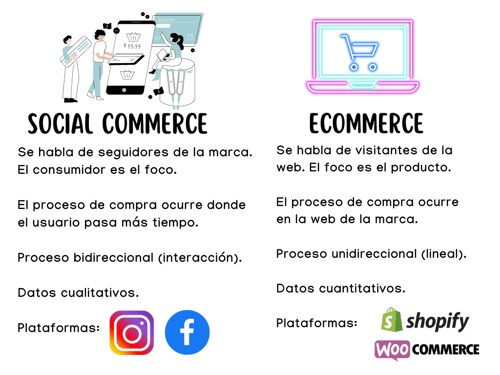Social commerce, what it is and how it helps us to promote our business
Index Content
Social commerce is an e-commerce trend that focuses on the use of social networks as a sales channel. This method encourages interactivity between users and takes advantage of the massification of social networks to optimise the shopping experience for customers and increase brand reach. It allows users to buy products and services through the application where they spend the most time. The entire shopping journey happens in the same place. This simplifies the payment process and the subsequent reaction to the product. This form of commerce provides security for buyers as it takes place in the user's social circle.
Generally, people spend a lot of time on social networks and, thanks to the emergence of ecommerce, they also shop online. Social commerce goes one step further and combines both consumer habits to streamline the shopping experience and avoid any obstacles or distractions that may arise. This is an additional feature that generates more sales and reaffirms the customer. Social commerce is a subset within ecommerce. Depending on the company's target, it will be favourable to use one sales method or another. For example, if the brand's target audience is young people between 16 and 24 years old, it will be appropriate to position itself on social media platforms.
Advantages of social commerce
- Encourages interaction: Social networks generate a social proof of the product, i.e. a proof of the quality of the service will be obtained through likes, comments or shared publications. In the same place where the sale is made, customers can write reviews or ask questions. In addition, influencer marketing can be used to promote the product among the followers of a micro-influencer. These will feel identified with the brand and will begin to trust it.
- Optimisation for mobile devices: Optimising mobile shopping in your company will position you among the competition. The majority of network users consult purchases through their mobile phones due to its immediacy.
- Increase audience: Traditional online shops offer many benefits, but social media is used by more users. Therefore, it ensures your brand's visibility among a large number of people worldwide. Social commerce is established and there are a number of audiences that use these platforms on a regular basis.
- Leverage followers: If your brand has a presence on social media, it is likely that you already have a number of followers. By carrying out a digital marketing strategy, these can be converted into buyers if you sell your products on these platforms.
- Improve brand awareness: Social commerce can generate brand awareness and loyalty among users because of its high interaction. By making purchases immediately and being able to give feedback on products, customers will have a good experience and are more likely to buy again.
Disadvantages of social commerce
- Requires more attention: To sell on social networks you must invest time and effort in optimising your content. This is necessary to attract the audience and make your brand stand out from the rest. It is advisable to create shareable, interactive and easy to consume content.
- Less traffic to the brand's website: Selling on social media puts the corporate website in second place. This consequence can be avoided by investing in targeted advertising to drive customers to the website.
- Exposure to criticism: Social proof has its downside. If a customer has a bad experience, they will write a bad review about the product creating a bad reputation for the brand. You should pay attention to criticism by trying to solve the most recurring problems.
- Limited users: If you focus your digital marketing strategy on social commerce you will target a global and versatile audience on social networks, but you will miss out on those consumers who are not part of these platforms. It is advisable to have a traditional online shop to reach all possible audiences.
Types of social commerce
- Plugins, chatbots and CTAs: These are easy to implement and their use depends on the purpose of your shop. Plugins allow you to connect an online shop to a certain social network. For example, there is a WooCommerce plugin that includes your shop in Facebook Marketplace. Chatbots are used to engage in conversation with a customer through AI and help them navigate through your online shop. Finally, CTAs are usually presented as stickers on social networks that serve as a link to direct the user to your website.
- Shoppable ads: Companies can sell their products through sponsored posts. Products are tagged in an ad to direct customers to the page of the displayed item. Afterwards, the success of the ad can be tracked to check the functionality of the marketing strategy.

- Social media checkout: Social media checkout facilitates the checkout process. From the platform, customers can choose product, size, colour and proceed to checkout, receive confirmation of purchase and follow up without leaving the application.
How to implement social commerce in your business
1. Have a clear objectiveTo apply social commerce to your sales process, it is important to know what objectives you want to achieve on social networks, i.e. to find out why your online shop needs to be present on these platforms and which ones it should be on.
2. Generate interaction and engagementIf the brand's content is not attractive to the user, it will be lost in the social network. Following the trend of the sector and the company, the content should be interactive and generate engagement. Videos and images are recommended to attract traffic to the online shop.
3. Stay activeIn social networks it is necessary to be consistent in order to stand out. Frequent publications will guarantee brand recognition and attract new followers. In addition, interaction with users must be dynamic and immediate in order to provide the right customer service.
4. Use SEM campaignsThe algorithms of social networks are constantly evolving. Therefore, making organised publications does not usually generate sales. Positioning yourself correctly through SEM campaigns will adapt your product to the new digital marketing trends. To do this, you can carry out actions such as disseminating promotions, discounts or competitions.
Platforms for social commerce
TikTok: It has the highest engagement rate of all social networks. Therefore, it is recommended that your brand has an active profile on this platform. In addition, they have the functions of TikTok Shopping to implement social commerce in your business. With the TikTok Pixel add-on you can analyse analytics on the behaviour of users with the brand.
Facebook: Facebook Shops is used to position your online shop within the social network itself. It allows you to synchronise sales, interact with customers and suggest products, among other things. To do this, you need to create a Facebook Business profile and enjoy its many advantages.
Instagram: Instagram Shopping is used for effective social commerce. It is a place to buy and sell products through which you can create storytellings, posts and shoppable ads. You need to have an Instagram Business account to enjoy this tool.
Pinterest: Pinterest offers the user a wide range of products. This can play to the benefit of the brand as it is a sales opportunity. Through the catalogue of this platform you can make our services known. These must have outstanding features because in this social network it is common to make comparative lists before making a purchase.
Examples of brands that do social commerce
- Pull & Bear: This fashion shop from the Inditex group has a notable presence on Instagram. It is common to find influencers wearing their clothes and tagging their products. In addition, it is constantly growing due to its updates. For example, they incorporated cameras in their fitting rooms that could be used, through a Facebook application, to take a photo of you wearing what you were trying on and share it on the platform to receive opinions.
- Amazon: This commercial platform bases its operation on selling products from other companies. Thus, on their social networks they do not promote their services directly, but create content encouraging the purchase of a brand within their platform. Despite using a different strategy, they achieve a high level of brand recognition and trust from users.
- Shein: This company operates through e-commerce. Their niche market is on social networks, so they are very active on platforms such as Instagram Shopping. They offer a wide catalogue with tags that they include in their publications. They receive positive feedback from consumers and work with fashion bloggers to receive greater recognition.






